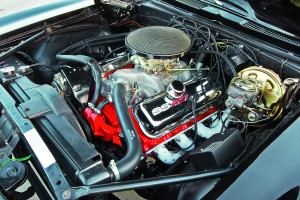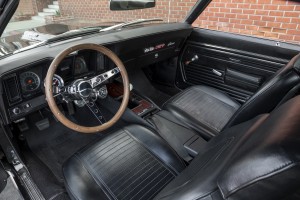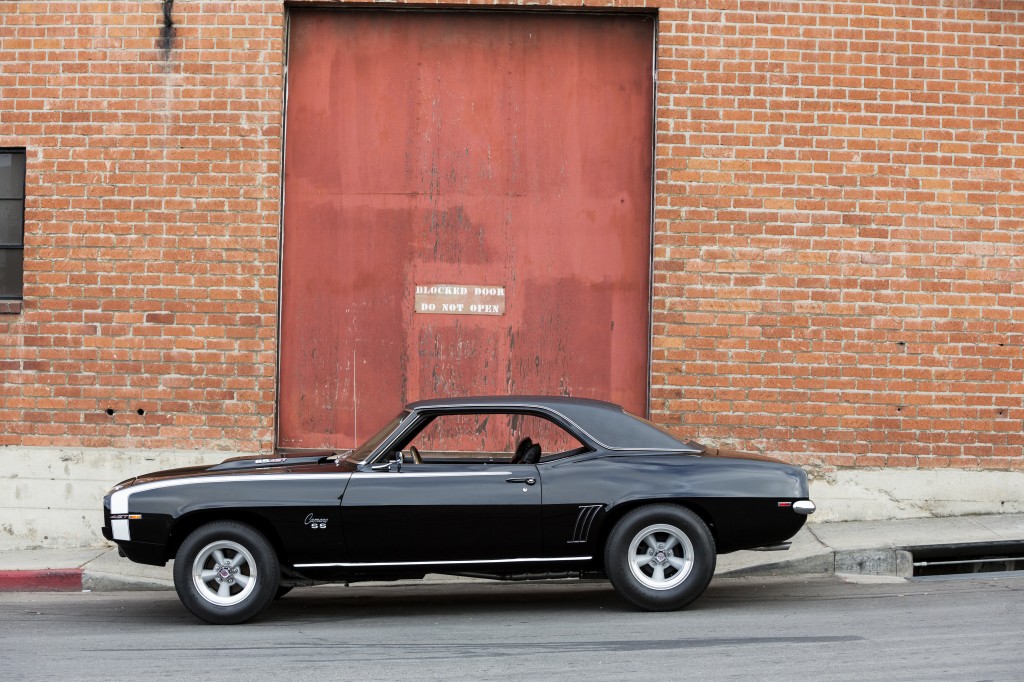By Joe Oldham/courtesy of Hemming Muscle Machines
I knew I had a problem the second I opened the door to the underground garage of our apartment building. They were already at the car, one guy snaking in a piece of wire hanger through the driver-side weatherstripping, the other looking on. I immediately ran at them screaming, and after a brief struggle, they both ran out the open garage door.
After that incident, I went down to the garage to check on the car about every half hour for the next two months. Most cars aren’t worth that kind of trouble, but this wasn’t just any car. It was my new triple-black 1969 Baldwin-Motion SS 427 Camaro, custom-ordered through Dave Bean at Baldwin Chevrolet in Baldwin, NY, and custom-built by Joel Rosen and Motion Performance.

You want attitude? Joe Oldham’s recreation of his 1969 Baldwin-Motion Camaro sports a ’glass Stinger hood, Torq-Thrust wheels, and chambered exhaust pipes. That made for serious street cred in the ’60s.
The car was born at GM’s Norwood, OH assembly plant as an SS 396 L78 coupe, but Motion Performance pulled that engine and dropped in a crate L72 427 rated at 425 horsepower. Mine was mildly modified with a set of Hooker headers, Mallory CD ignition, Turbo 400 tranny with shift kit, modified suspension, power windows, and Torq-Thrust wheels. Motion Performance used the car in several full-page magazine ads (“Wanted,” “Outrageous,” “Moment of Truth”) during the 1969 model year, on the cover of the Motion catalog and in the Motion display at the New York Rod and Custom Show at the New York Coliseum. Plus, both Marty Schorr, editor of Hi-Performance Cars magazine, and myself had extensively photographed the car, and several magazine articles were published about it in late 1968 and early 1969. I street raced it all around the New York City area and just generally enjoyed the car.
And then one morning it was gone.
I reported the theft to the cops that spring morning in 1969, but they couldn’t do anything. I wasn’t around to chase off the thieves that morning–and I spent the next 45 years wondering if I’d ever see my 1969 again. Then, about five years ago, my son, Scott, had an idea:
“Dad, why don’t we build a replica of your old Baldwin-Motion car? You see a million Yenko clones, you see other Baldwin-Motion tribute cars, but no one has ever built a replica of your car, even though it’s one of the most famous Baldwin-Motion cars of all time.”
He was right. In the ensuing years, the car had become famous. The “Wanted” poster ad had become a collectible in its own right, and there were online discussions about the car (Google “Joe Oldham’s Camaro”). It had also appeared in my own book, Muscle Car Confidential, as well as Marty Schorr’s Motion Performance, Tales of a Muscle Car Builder.
Yet no one had built a clone.
I resisted the idea of building a clone for about five years, but Scott was persistent and I finally caved.
I am a detail freak so I told Scott that we’d have to go all-out on the project. We had to be fanatical about getting all the little details right, or it wouldn’t be the reincarnation of my old car; it would just be another black Camaro with a hood scoop. Luckily, I had kept all of my old photos of the original, so we could chase down those details–from the routing of wires to the direction of the hose clamp.
About a year later, we found the perfect donor car in an online listing in Glendale, AZ. We wanted a big-block, four-speed, 12-bolt-rear car with virtually no rust, and it met our criteria. Somewhere down the line, somebody had taken a standard Le Mans Blue ’69 V8 coupe, restored the body to number two condition, converted it to an SS big-block four-speed, and painted it black with a white hockey stripe.
We bought it and drove it home to California.
First stop was Walker Auto Works in Bermuda Dunes, CA for an overall safety and reliability check. Owner Randy Walker replaced the belts and hoses, installed a new 10.5-inch Centerforce clutch, and welded up one of the four tangs bolting the transmission to the bellhousing, which had cracked off. Meanwhile, we began accumulating parts—aftermarket stuff as well as original and reproduction restoration parts. Summit Racing Equipment, Classic Industries, and other muscle car parts company catalogs and websites became nightly reading.

The Chevrolet Performance ZZ427 was painstakingly dressed to replicate the original 427 with a mix of vintage bits, new retro items and a fabricated recreation of the extinct Mallory ignition box. The Hooker Super Competition headers were painted white just like they were back in the day.
We originally wanted to drop in a stock L72 427 all-steel engine to replicate what was in my original car. But the L72 packs 11:1 compression ratio and solid lifters and wouldn’t run on California’s 91-octane pump gas. Instead, we decided on the ZZ427 crate engine from the Chevrolet Performance Parts catalog. It’s a 427, just like the L72, but with aluminum heads and a pump-gas friendly 10.1:1 compression ratio. As GM states in the catalog, it’s a modern take on the old L88 powerplant–similar in many ways but with a modern hydraulic roller-lifter cam. The cast-iron, four-bolt-main block packs a forged steel crankshaft and connecting rods, forged pistons, and a .527-inch /.544-lift camshaft. The whole package is rated 480 horsepower at 5,800 rpm and 490 ft.-lbs. of torque at 3,900 rpm–a considerable step up from my old L72.
Unfortunately, the ZZ427 looks considerably different from a 1969 L72 engine. Since our plan was to dress the exterior of the engine to look exactly like my original ’69 engine, we turned to Starlite Rod and Kustom in Torrance, CA for help. The shop, which is owned by Jack Fields and Edgar Hernandez, can build anything but specializes in very accurate period-correct 1960s customs. Plus, the shop is capable of both mechanical and bodywork.
They started by stripping the top of the engine—intake manifold, carburetor, valve covers, water pump, and distributor. To capture the look of old-school cast-iron heads, the shop filed the “GM Performance” logo embossed in the front of each cylinder head and secured a set of screw-in freeze plugs to complete the illusion. The entire long-block was then painted with POR-15 Chevy Orange and an exact-reproduction rectangle-port aluminum intake manifold with the Winters Foundry “W” snowflake logo was installed. The intake was topped with a new and spec-correct Holley 780 cfm double-pumper carburetor, and the modern HEI ignition was dumped in favor of an old-fashioned points distributor. A set of period-correct date-coded ignition wires were also installed.
For the exhaust, we sourced Summit Racing for a set of Hooker Super Competition headers, which were painted white like the headers on my old car. The original Camaro came with a chambered exhaust, which was a one-year-only option on big-block Camaros, and we found an exact reproduction of the system. This design eliminates mufflers altogether and instead relies on crimps every six inches along the length of the pipes to damp the exhaust noise. If you could hear the decibel level of this system, you would have a good idea of why it was a one-year-only option.
Lastly, we replaced the black, cast-aluminum valve covers that came on the ZZ427 with vintage chromed, stamped-steel units. Then we added the signature “Fly Eye” air cleaner, which was a fixture on the Motion cars and now costs a small fortune on eBay. The finishing touch was the pair of 1968 Impala “SS 427” emblems added to the valve covers, just as I asked Joel Rosen to do 45 years ago.

This was the view many a street racer saw of Joe Oldham’s original Baldwin-Motion Camaro back in 1968 and early ’69. Dig the vinyl top.
More custom fabrication was needed to recreate the Mallory Magic Box capacitive discharge ignition, which has become a virtual unicorn. Heck, most people have never even heard of it. And, after a year of searching, we were only able to track down a single surviving unit, which its owner made vehemently clear was not for sale at any price. After consulting with Joel Rosen and Marty Schorr about more commonly available alternatives, and with only three weeks to go before the car’s debut at the Muscle Car and Corvette Nationals in Chicago, we decided to just make our own. Again, working from some of my old photos, Jack Fields fabricated a nonfunctioning but exact visual replica of a Mallory Magic Box, right down to the artwork on the small aluminum plate. He then mounted it to the inner fender of the Camaro just as the Motion boys did four decades earlier.
Since my original Baldwin-Motion Camaro was a daily driver in New York City, the three-speed Turbo 400 was the ideal choice. However, we opted to stay with the Muncie M-21 close-ratio four-speed transmission and 12-bolt Posi rear that came with our donor car for this project. It’s the one concession from authenticity we made, but we thought it’d be fun to throw gears–especially now that we live away from the city. The donor car even had a Hurst Competition Plus shifter already installed!
The bodywork started with a fiberglass scooped “Stinger” hood exactly like the one Motion Performance installed on the original ’69. We ordered it from Summit Racing, along with a silver grille assembly and a VE3 urethane bumper to replace the chrome unit on the car. Starlite removed the steel SS hood, incorrect black grille and chrome bumper, chrome trim moldings around the wheel wells, and rear spoiler. After filling some holes, they painted everything in glossy black and installed a vinyl top with correct moldings and grain. Lastly, we installed SS427 emblems on each side of the hood scoop and cut one in half to install between the taillights and added red Impala “427” emblems on the front fenders—just like on my old car.
In the 1960s, drag racers were going en mass to the high-rider look because they thought it provided the best weight transfer. My original ’69 had this same setup, which combined several coil spreaders to raise the front ride height with rear air shocks to level off the rear. The car also had a set of proprietary Motion SuperBite traction bars painted in stealthy black.
We wanted this same look for our Baldwin-Motion clone.
Motion SuperBite traction bars no longer exist, so the guys at Starlite fabricated an exact duplicate set from bar stock, based on photos of the old ones. Our donor car came with heavy-duty rear springs that had an extra leaf on each side, giving the car the perfect starting point for our high-rider look. To level off the car, we installed new big-block front springs with an aluminum spacer atop each spring. A set of Coker Tire Pro-Trac bias-ply tires and American Racing Torq-Thrust Original wheels continued the old-school theme.

That wood steering wheel is a Grant item that the author selected in 1969; it’s still offered today. Column-mounted Sun tach is a ’60s staple. Vintage Sun Blue Line gauges were found and refurbished by Redline Gauge Works. The four-speed is only real deviation from the original car, which had a Turbo 400 automatic.
The donor car’s interior was in decent condition but needed a freshening. We ordered replacement seat padding, seat covers, and a new instrument panel from Summit Racing, along with a new console which the donor car lacked. We swapped the steering wheel for a riveted Grant wood steering wheel like the one in the original Camaro. Instead of ordering the factory gauges in my original, I had Motion install a full set of Sun Blue Line gauges. We found a set of these same gauges on eBay, installed them in our dash, and then strapped an old-school Sunpro Retro Super Tach to the steering column. We also installed a new audio head unit, which features modern guts and an iPod hookup. The pièce de résistance was another SS427 emblem mounted on the passenger side of the dash. They should know what car they’re in.
During the six-month build, Scott monitored the day-to-day activity at Starlite, and I had been kept informed of goings-on through emails, text messages, and photos. However, I had yet to see the car in person when Scott asked me to come out to his house to take a look. I expected to see a 1969 Chevrolet Camaro sitting proudly in his driveway, but there was Scott in my old 1969 Baldwin-Motion Camaro.
It looked like it anyway.
It was if I stepped back in time. It was 1969, and I was 26 all over again.
They say you can’t go back, but for one instant, I did. And it was good.
EDITOR’S NOTE: Summit Racing now offers Joe Oldham Baldwin-Motion Camaro Combos that feature many of the parts used to recreate his ’69.


Nice article, really enjoyed reading it!
[…] صفحه مربوط به اين عکس :Time Traveler: Recreating a Legendary 1969 Baldwin-Motion SS427 … […]
I really enjoyed your article. I remember a similar Camaro that was also stolen in Cambria Heights, NY about a year earlier. It was a beautiful car and had Ansen sprint mags, the 427 engine option a 4-speeed trans with a 121-bolt rear, a Hone overdrive and a fiberglass, “stinger” scooped hood. I’ve always wanted to clone this car and I just may give it a try thanks to your story.
Was the Mallory Magic Box sold over the counter ? My 69 I bought has one on it , any info appreciated
I have a 69 Camaro my husband bought it for me 33yrs ago for Mother’s Day, I love speed it’s not the fastest but I love it, its black convertible ss 4 speed separate shifter for reverse hideaway head lights 468 engine, wanted to share with you the love of 69 Camaro !!